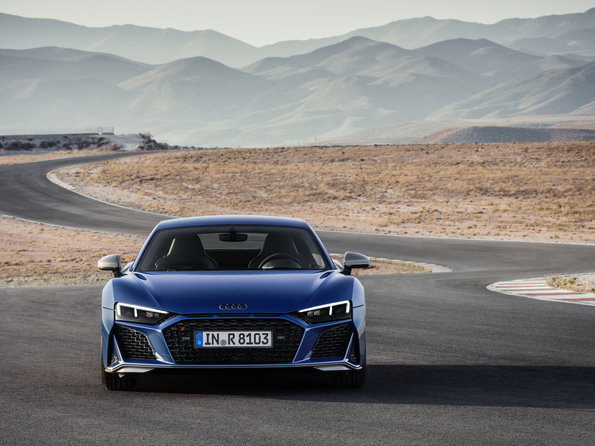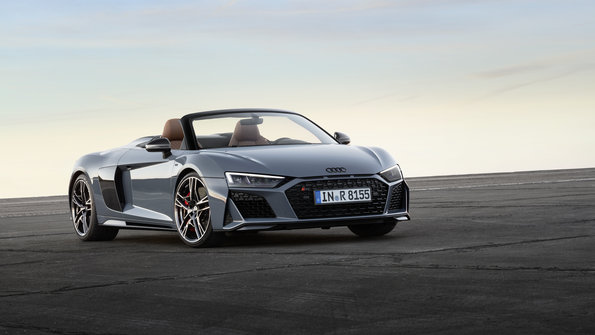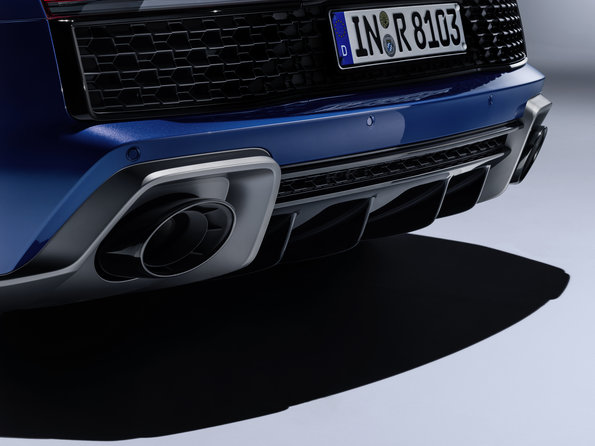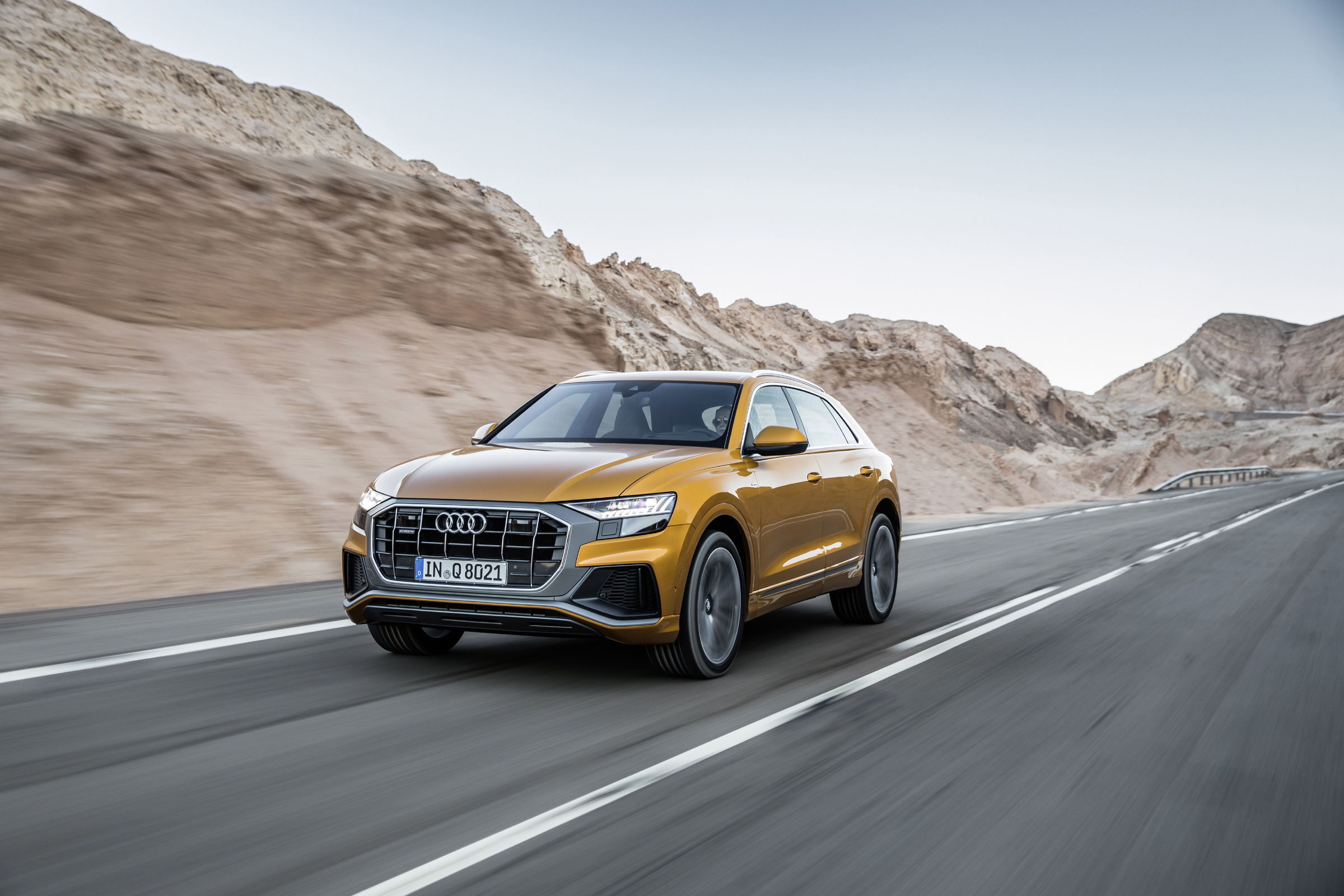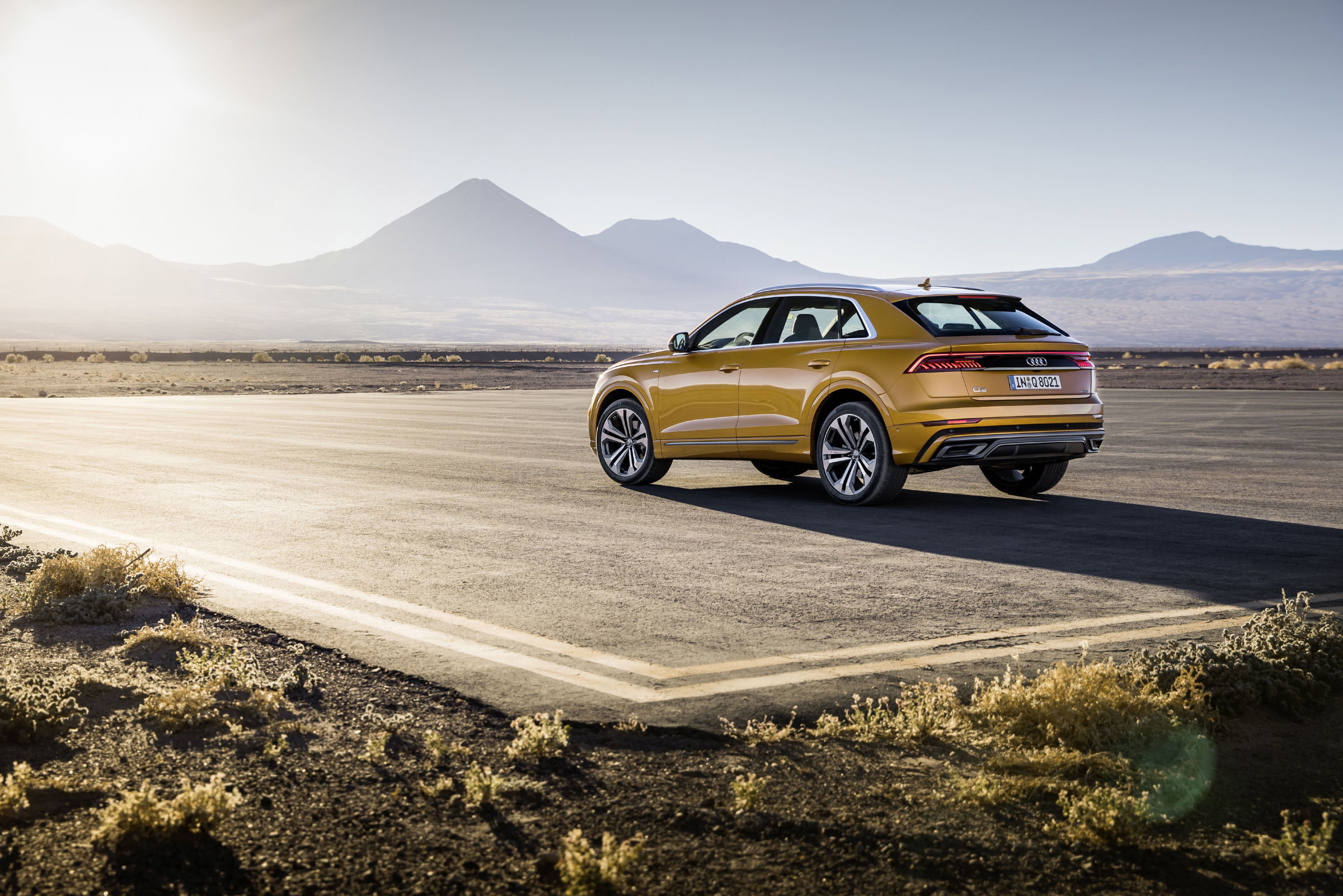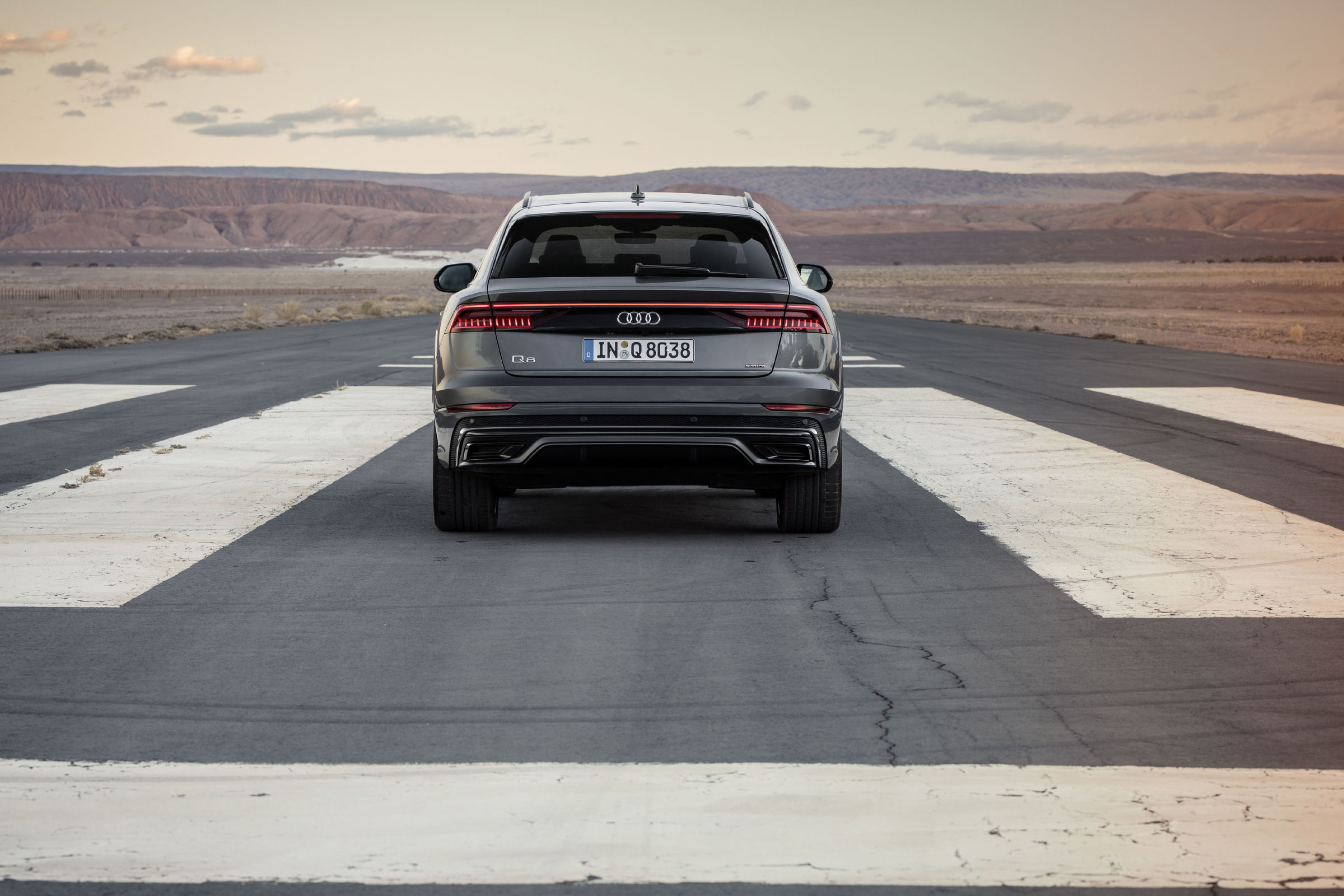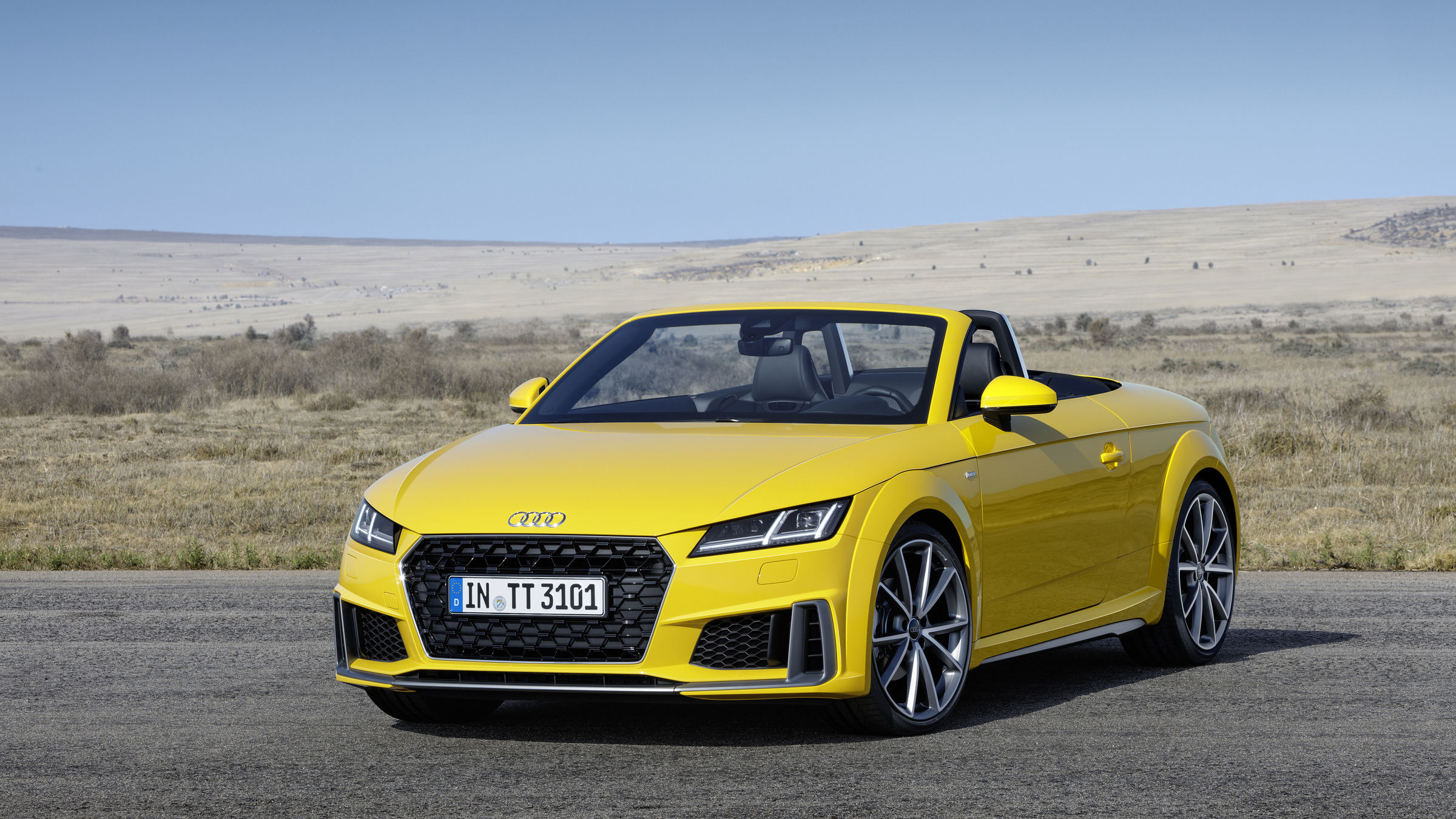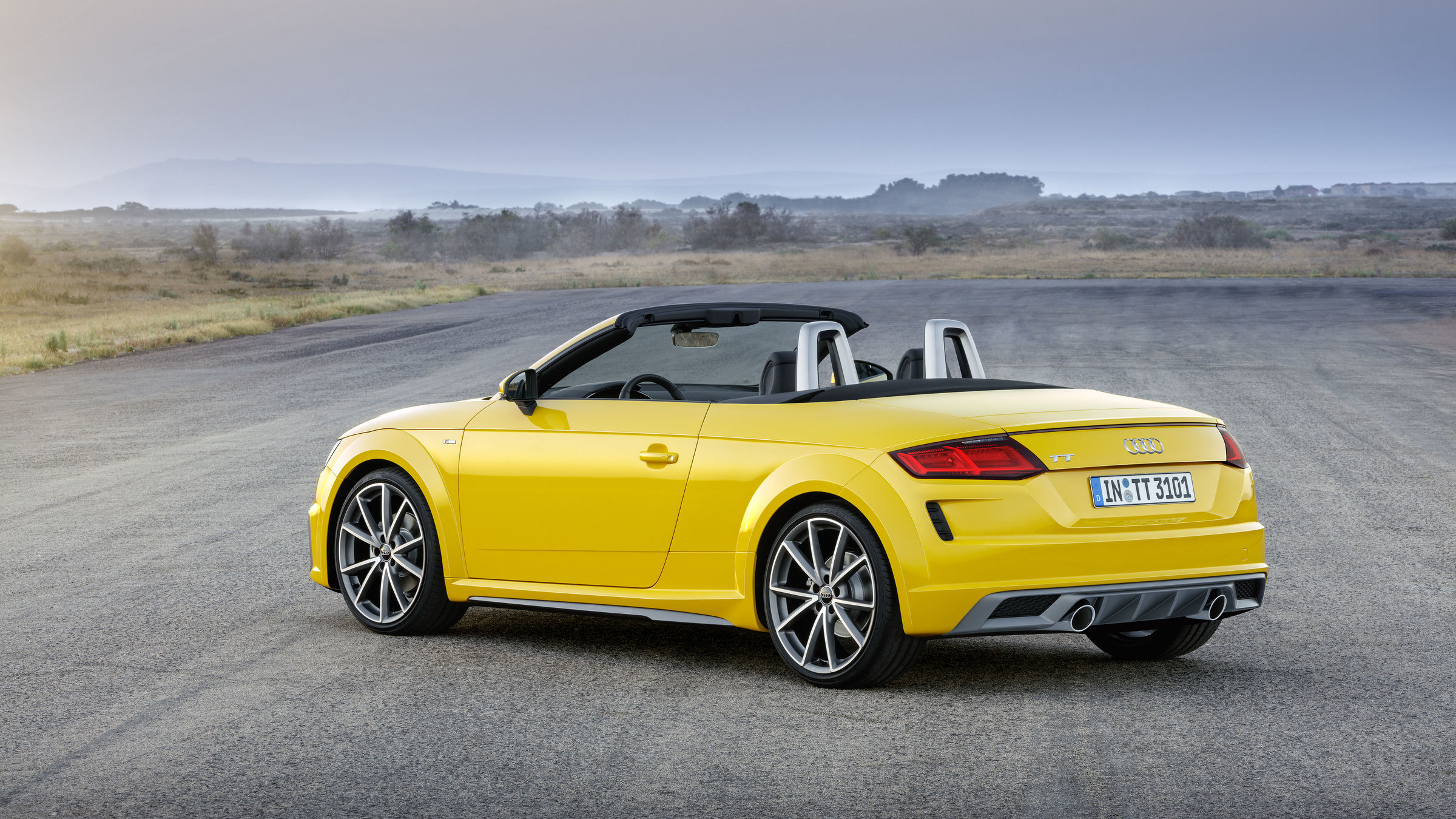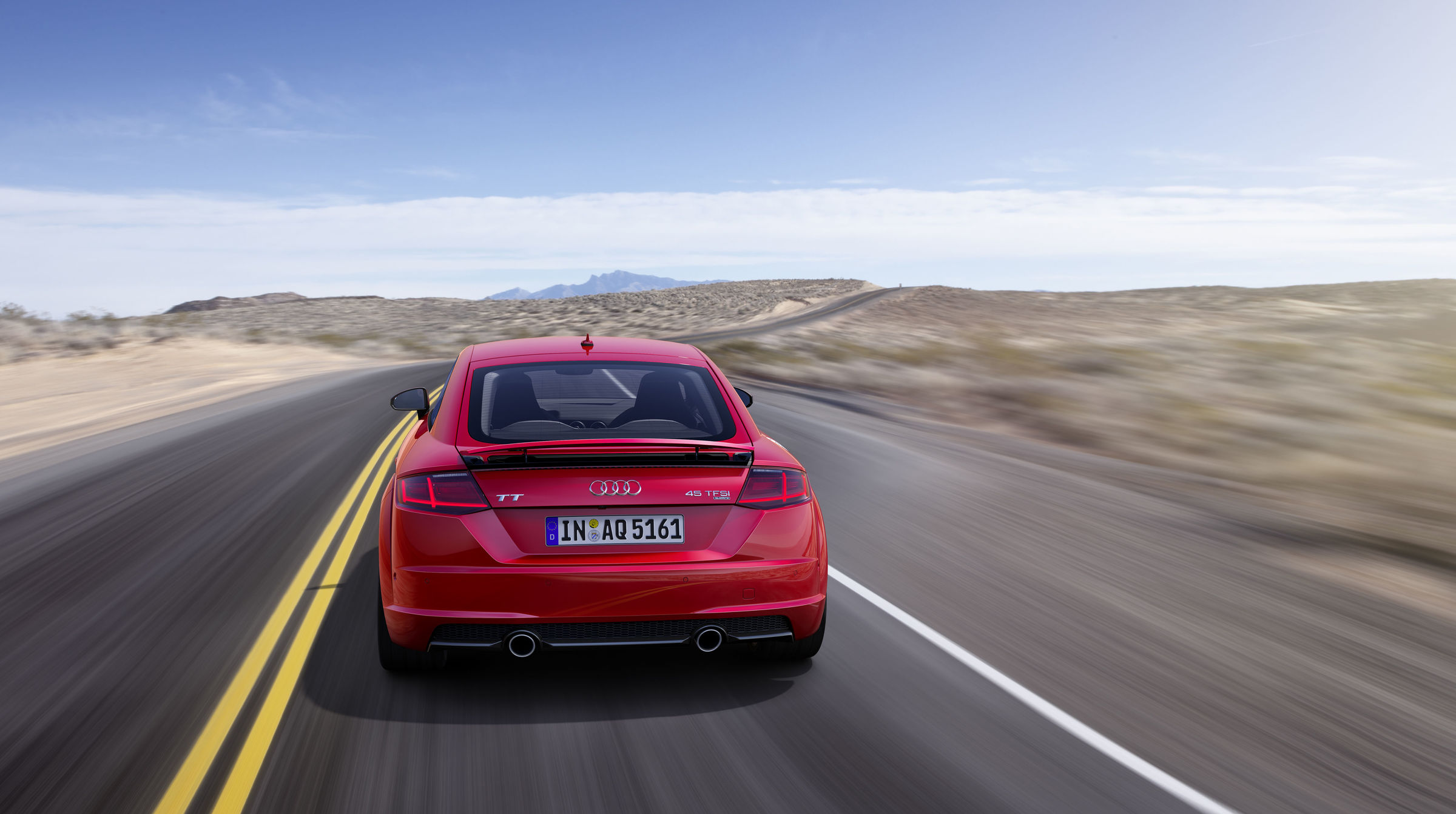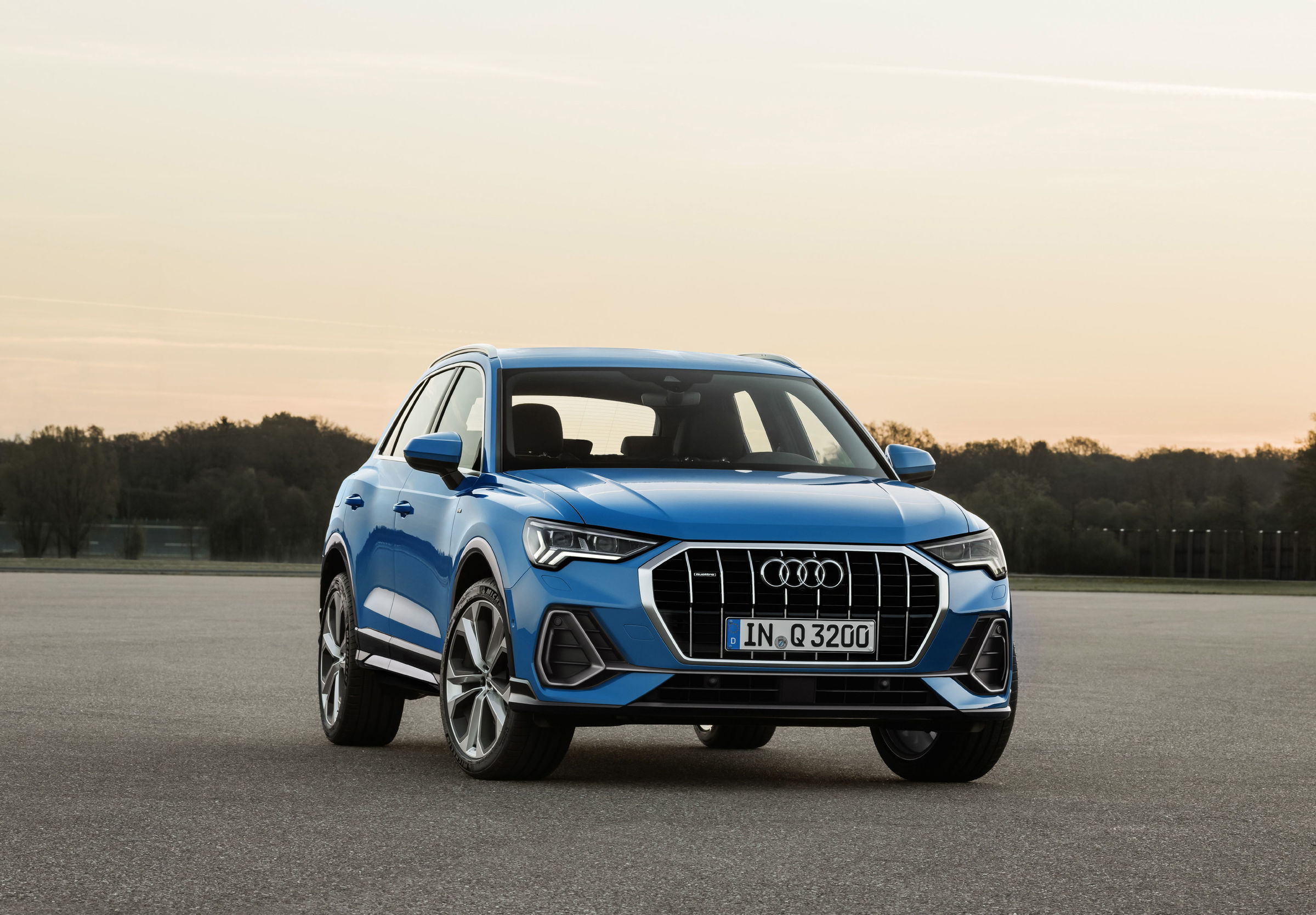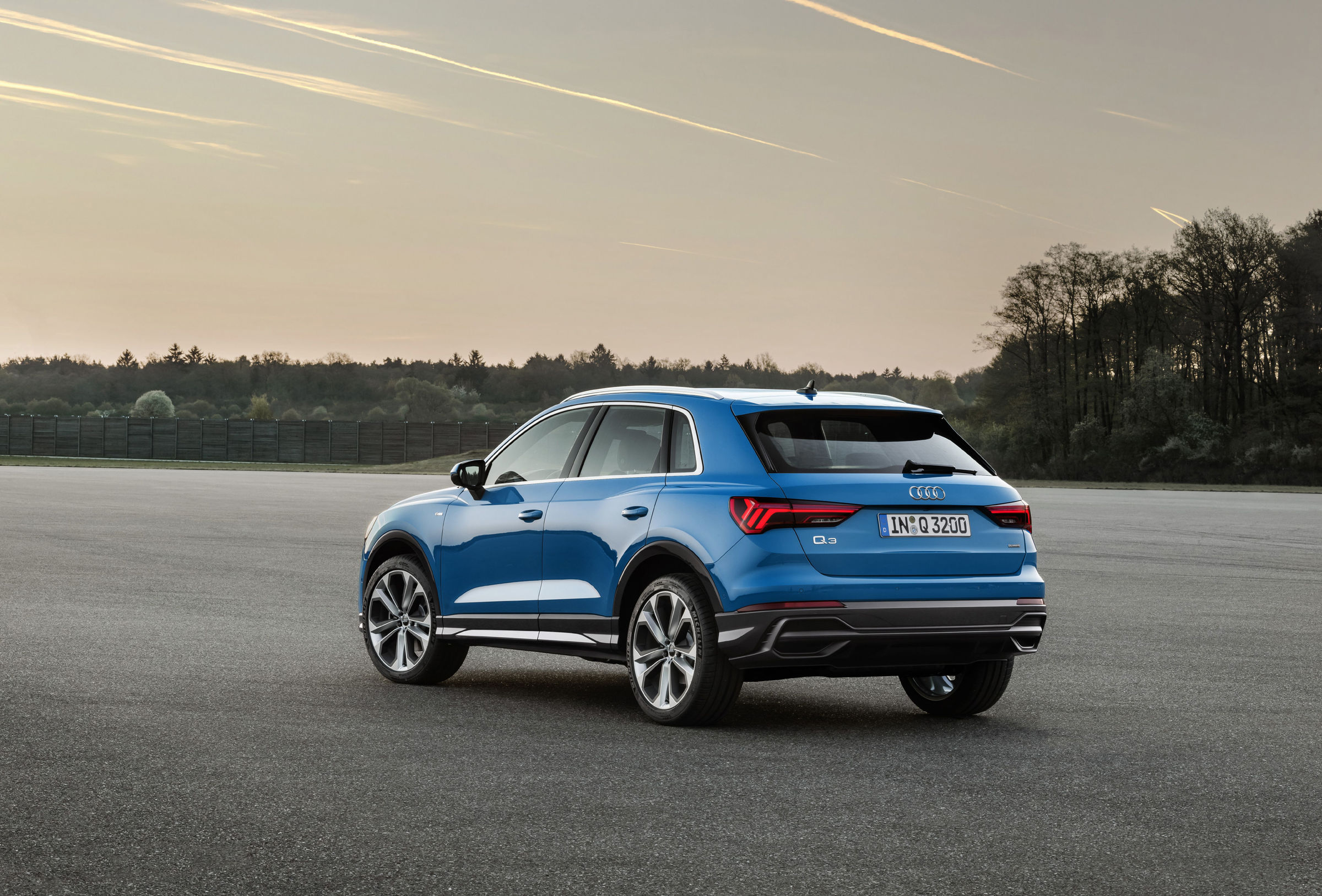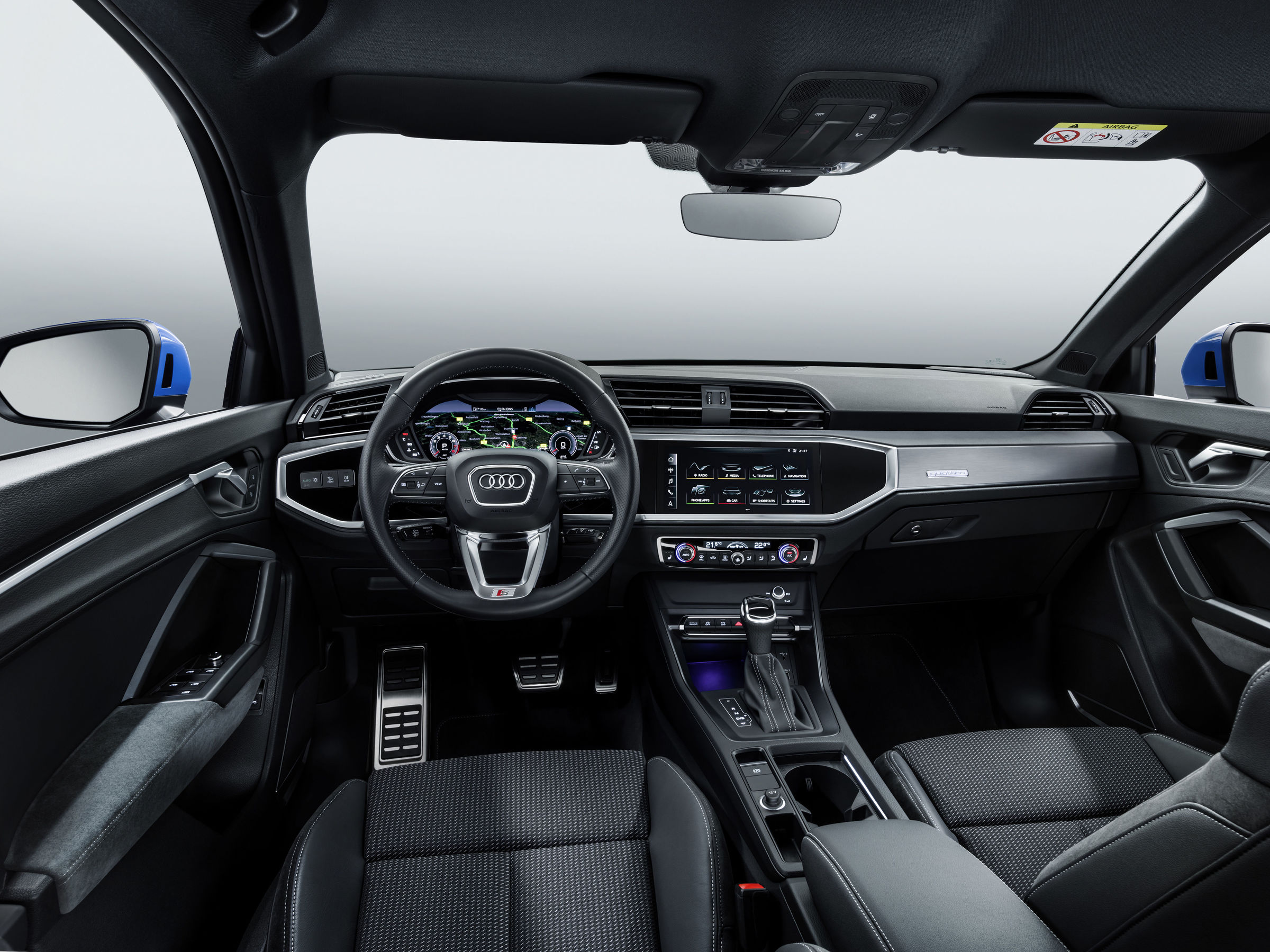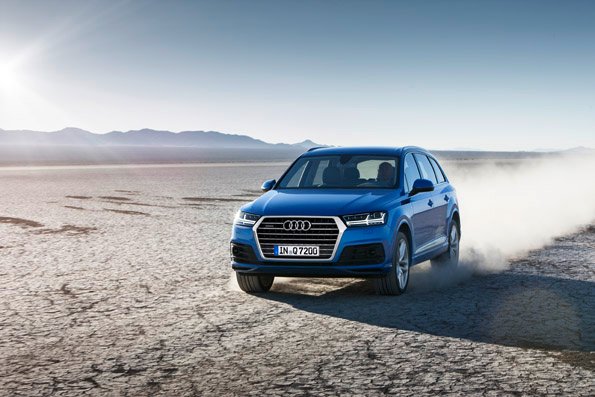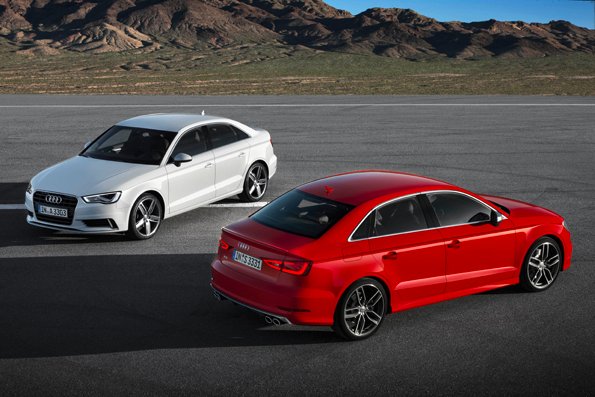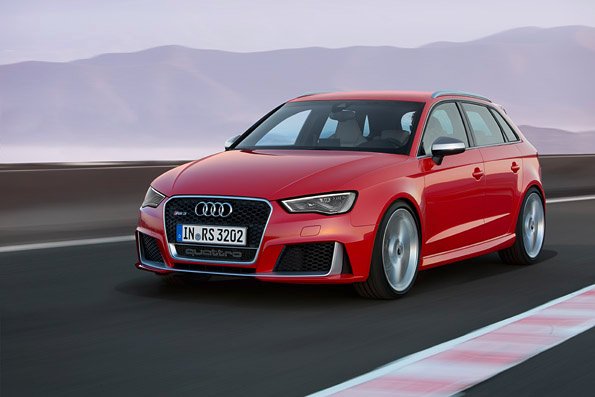With the new Q7*, Audi is setting standards in the premium SUV segment. Up to 325 kilograms less weight and the low center of mass make it extremely agile. At the same time, it is the most spacious car in its segment. Although the exterior dimensions have gotten smaller, it offers substantially more interior room for passengers and luggage. Its innovative assistance and infotainment systems take the SUV to the front of the pack. The efficient engines consume 26 percent less fuel on average.

Prof. Dr. Ulrich Hackenberg, Audi Board Member for Technical Development: “The new Audi Q7 is a statement of our competence. Weighing up to 325 kilograms (716.5 lb) less, it sets the benchmark in its class. It is around 26 percent more efficient and is equipped with the latest assistance systems, infotainment modules and connect features.”
With a curb weight of just 1,995 kilograms (4,398.2 lb) (as 3.0 TDI), the new Audi Q7 is the lightest in its class. It weighs up to 325 kilograms (716.5 lb) less than the previous model. With its lightweight, multimaterial body and an all-new chassis, it is comfortable while at the same time offering the typical performance of a sporty Audi – and that with top-notch CO2 values. Audi engineers have reduced the fuel consumption of the Q7 by as much as 28 percent (TFSI) and 23 percent (TDI).
The engines set top marks in the segment of large SUVs with all-wheel drive. The 3.0 TDI with 200 kW (272 hp) and the 3.0 TFSI with 245 kW (333 hp) accelerate the new Audi Q7 from 0 to 100 km/h (62.1 mph) in 6.1 seconds (TFSI) and 6.3 seconds (TDI), respectively. The diesel V6 consumes on average just 5.7 liters of fuel per 100 kilometers (41.3 US mpg), corresponding to 149 grams of CO2 per kilometer (239.8 g/mi).
The Audi Q7 also sets standards with respect to the operating concept, infotainment, connectivity and driver assistance systems. The second-generation modular infotainment platform is on board, as is the Audi virtual cockpit. The new MMI all‑in‑touch control unit with large touchpad makes operation child’s play. Other attractive innovations include the expanded services from Audi connect, the Audi tablet for the rear seat passengers and the two sound systems with 3D audio. Smartphone integration with Google Android Auto and Apple CarPlay is also new. The new Audi Q7 is one of the first cars worldwide to offer these functions.
One highlight is the comprehensive portfolio of new driver assistance systems, including adaptive cruise control with traffic jam assistant. No other production vehicle in the world currently offers more.
The Audi Q7 e‑tron quattro, which will be launched a short time later, is the first plug in hybrid from Audi with a diesel engine. It impresses with system 275 kW (373 hp) of system output and a system torque of 700 Nm (516.3 lb‑ft), and is also the world’s first diesel plug‑in hybrid with quattro all‑wheel drive in the premium SUV segment. It consumes in the NEDC just 1.7 liters per 100 kilometers (138.4 US mpg), which corresponds to less than 50 grams CO2 per kilometer (80.5 g/mi). A full battery charge is sufficient for a distance of 56 kilometers (34.8 mi).
The new Audi Q7.
Audi presents the new Audi Q7* at the North American International Auto Show in Detroit. With the second generation of the large SUV, the brand with the four rings is setting new standards in its market segment. The drivetrain, chassis, lightweight construction, assistance systems and infotainment impress with innovative technology. The new Audi Q7 is up to 325 kilograms (716.5 lb) lighter than its predecessor and reduces CO2 emissions by as much as 50 grams per kilometer (80.5 g/mi). Scheduled to follow shortly after the market launch, the Audi Q7 e‑tron quattro is the world’s first plug-in hybrid with a six-cylinder diesel engine and quattro all-wheel drive.
Prof. Dr. Ulrich Hackenberg, Audi Board Member for Technical Development: “The new Q7 also marks the debut of the second-generation modular longitudinal platform, the Audi technology matrix for models with longitudinally mounted engines. Efficient development and manufacturing provide Audi with flexibility for offering new technologies and drive variants. The new Audi Q7 is a statement of our competence. Weighing up to 325 kilograms (716.5 lb) less, it sets the benchmark in its class. It is around 26 percent more efficient and is equipped with the latest assistance systems, infotainment modules and connect features.”
71 kilograms (156.5 lb) less weight: Body
The new Q7 is an imposing car with the best height:weight ratio in its class: 5.05 meters (16.6 ft) long, a 2.99 meter (9.8 ft) wheelbase, 1.97 meters (6.5 ft) wide and 1.74 meters (5.7 ft) tall (with steel suspension). Although it is shorter and narrower than its predecessor, the cabin is longer and offers more head room.
20 years of experience with lightweight construction flow into the new Audi Q7. Equipped with the 3.0 TDI engine, the new Audi Q7 tips the scales at just 1,995 kilograms (4,398 lb), which is 325 kilograms (716.5 lb) less weight – the equivalent of a concert grand piano. The Q7 with the 3.0 TFSI engine is even lighter, weighing just 1,970 kilograms (4,343.1 lb). Lightweight construction has been applied in all areas, from the electrical system to the luggage compartment floor. The key is the body structure, where a new multimaterial design reduces its weight by 71 kilograms (156.5 lb). This places the new Q7 among the best in its segment.
Ultra-high-strength parts made of hot-shaped steel form the backbone of the occupant cell. Aluminum castings, extruded sections and panels are used in the front and rear ends as well as the superstructure. They account for 41 percent of the body structure. Other parts made entirely of aluminum are the doors, which shave 24 kilograms (52.9 lb) of weight, the front fenders, the engine hood and the rear hatch. Audi uses new manufacturing methods for the production and assembly of the parts. The crash safety and occupant protection of the new Audi Q7 are also on the highest level.
Three torsion rings reinforce the front end, the area of the C-pillars and the rear hatch cutout. These play a major role in the vastly improved static and dynamic stiffness of the body. The torsion rings are the foundation for the precise handling and superior vibrational comfort in the car’s interior.
Quiet on board
The premium acoustic insulation reinforces the impression of solidity and elegance by providing for a unique degree of quietness in every situation. The best-in-class aeroacoustics result from the interplay between various vehicle components, such as the mirror mounted on the shoulder line.
The big SUV has a cd value of just 0.32. This top mark in the segment is the result of sophisticated technical solutions. The underbody is nearly completely lined; a small spoiler in the area of the rear axle reduces lift. The efficiency model – the V6 TDI with 160 kW (218 hp) which will be launchend at a later date – features louvers between the Singleframe grille and the top section of the main radiator. The plastic slats open and – for better aerodynamics – close as necessary. This is based on an energy-optimized controller for maximum cd advantage.
Confident: Exterior design
The proportions have changed compared with the previous model. The big SUV is 37 millimeters (1.5 in) shorter and 15 millimeters (0.6 in) narrower while virtually the same height. Inside, however, there is an additional 21 millimeters (0.8 in) between the first and second rows of seats, and head room has increased by 41 millimeters (1.6 in) and 23 millimeters (0.9 in) in the first and second rows, respectively.
The design of the new Q7 is masculine and determined. Horizontal lines extend above the wheels. These blisters are a subtle homage to the classic quattro models from Audi. The exterior mirrors are mounted on the shoulders of the doors; blades run from the front to the rear doors and bear embossed quattro logos. The rear hatch wraps around the massive, steeply raked D-pillars, a typical feature of the Q models from Audi.
The Singleframe grille is deeply sculpted and features thick crossbars. It is integrated organically into the front end. Its broad frame extends to the headlights, which feature either xenon, LED or Matrix LED technology, depending on the option chosen by the customer. The daytime running lights of the LED headlights are shaped like a double arrow. The taillights of the top model include dynamic turn signals – another Audi innovation.
New look: Trim strips and add-on parts
Four of the eleven exterior colors available for the Q7 are new. All of the trim strips adorning the body of the big SUV have a matt aluminum-look finish for a sporty, modern appearance. Bolt-on parts such as the door inlays and underbody protection front and rear come standard with a silver paint finish. In the base configuration, the bottom section of the bumpers and the wheel arches are anthracite, textured plastic. These are also available in the body color as an option. Borrowing from the bolt-on parts, the radiator grille is finished with a new, lightly structured paint that underscores the off-road character of the car.
With the second alternative – the S line exterior package – the bumpers, the air inlets, the side sills, the roof spoiler and the diffuser feature a particularly bold design. The radiator grille and the slats in the lateral air intakes feature a newly developed, progressive, dark gray, high-gloss finish that replaces the familiar high-gloss black.
Audi offers an optional power trailer hitch with trailer assistant. The new Audi Q7 has a towing capacity of 3.5 metric tons if equipped with the optional air suspension.
Broadly stretched lines: Interior design
The new Audi Q7 welcomes its passengers with an atmosphere of cultivated elegance and spaciousness. The interior design appears tautly stretched; the two‑piece inlays are available in various material combinations. The double application strip in the doors provides for a sense of lightness.
The instrument panel is visually separated from the center console, supporting the sportiness and lightness of the interior.
Feeling of safety and protection: The wrap-around
A wrap-around running from the doors through the instrument panel to form a sort of protective shield gives the driver and passengers a feeling of protection. The interface components are tailored specifically to the Audi Q7. They are located on the center console, which is oriented toward the driver. The shapes and contours of the interface components harmonize well with the interior architecture. The lines of the air vents point to the instrument cluster and further reinforce the driver orientation.
The ambient lighting uses LEDs exclusively. A second variant of the ambient lighting is available as an alternative. Ultra-narrow light guides follow the contours on the instrument panel and in the doors (including exit warning) as standard, and in an upgrade option they also include the center tunnel console. Now for the first time this lighting can be controlled via the MMI. In the top package, various colors can be selected.
Color and equipment: Diverse equipment variants
With the colors and materials used in the Q7, Audi is showing a new expression of lightness, sportiness and luxury in the premium SUV segment. The instrument panel is separated horizontally into two colors, which enables brighter colors to be used on the bottom. There are seven interior colors from which to choose. The two-piece application strip is available in a variety of material combinations. Besides high-quality effect finishes, there are a number of aluminum and wood variants from which to choose, including Beaufort walnut. Audi offer a choice of fabric, Alcantara, robust Cricket leather and fine Valcona leather for the seat coverings.
For customers seeking even more individuality, Audi offers three leather packages and two design selections. One elegant and one sporty design include full leather with contrast stitching, Alcantara headlining, luxury velour floor mats plus exclusive color and material combinations and application strips. The Audi exclusive range offers many additional customization options.
Even more room than in the previous model: The space concept
With the longest cabin in its class despite shorter exterior length, the new Audi Q7 offers more space than its predecessor. Passengers enjoy more head, shoulder and knee room. The space concept is highly variable. Audi provides an extremely comfortable three-seat unit with adjustable seatbacks for the second row. If desired, all three seats can each be moved longitudinally up to 110 millimeters (4.3 in), 10 millimeters (0.4 in) more than before.
Another option is for two individual seats in the third row that are certified as Group 3 child seats. These turn the Audi Q7 into a seven-seater with even greater utility. 24 millimeters (0.9 in) more head room and 20 millimeters (0.8 in) more shoulder room provide for more space. With the seats folded down, the seat backs are integrated into the cargo floor and can be raised or lowered electrically using rocker switches ergonomically located in the area of the C-pillars and in the cargo compartment.
For optimal access to the third row, the seats in the second row can be folded down and tipped up on edge as a compact package, providing an entry width of 376 millimeters (14.8 in). All seats in the second and third rows have Isofix/i-Size fixtures for child seats. Customers can thus mount up to six child seats in the new Audi Q7. Roller blinds and dark “privacy” glazing is optionally available for the rear. The panoramic glass sunroof – another option – makes the generous interior even brighter and airier.
If all seven seats are occupied, the cargo compartment of the new Audi Q7 has a capacity of 295 liters (10.4 cu ft), 770 liters (27.2 cu ft) in load configuration. The five-seater offers 890 liters (31.4 cu ft) and 2,075 liters (73.3 cu ft) with the second row seat backs folded down. To improve the usability of the cargo compartment, the developers lowered the loading lip by 46 millimeters (1.8 in) compared with the previous model. A power rear hatch is standard. In combination with the advanced key, Audi also offers gesture control – a kicking motion in the center below the rear hatch and the hatch opens automatically. The same foot gesture can also be used to close the hatch again.
A number of other options are available for making interactions with the big SUV practical and convenient: a power cargo compartment cover, power door closers and a heated windshield.
Fewer buttons for optimal ergonomics: Operation and display
All controls are framed in fine aluminum lines. They harmonize perfectly with the architecture – a reduced number of buttons while at the same time offering optimal ergonomics. Front seat choices are standard seats, standard seats with climate function, sport seats, sport seats with pneumatics and the custom contour seat. The design of the second and third row can be adapted to the variants chosen for the front seats.
The front seats offer driver and passenger plenty of space and comfort. Among the seat variants offered by Audi in the new Q7 are the multi-adjustable sport seat and the climate-controlled individual contour seat with up to 18 adjustments and optional massage function. The latter includes five different programs, each with a choice of five intensity levels.
Newly developed: Deluxe air conditioning
Audi equips the big SUV standard with a newly developed, two-zone deluxe air conditioning system. Its new operating concept uses fewer buttons and controls. Animated symbols in the display, the high-quality TFT display and the capacitive toggle switches provide for intuitive operation of the air conditioning. Audi also offers the option of a luxurious four-zone system, the temperature displays of which are integrated into the rotary dials. A display with toggle switches shows the status of selected functions. When the toggle switch is touched, the menu expands for better legibility and easier operation.
The right zone of the instrument panel includes a continuous air vent strip – including continuous chrome application – from which the air exits indirectly and draft-free. Both air conditioning variants offer customers particularly high air quality in the cabin. In both fresh air and recirculation mode, the air conditioning system filters out fine particulates.
Playfully easy: the new MMI operating concept
The latest generation of the Audi MMI operating concept makes it easy to control the multitude of convenient and innovative functions in the Audi Q7. The innovative MMI search with intelligent suggestions makes it easier to search for specific song titles and to input telephone contacts or navigation destinations, thus significantly reducing the amount of time spent on these operations. Nearly all entries can be completed in just a few steps. Two supplemental menus contain intelligently linked functions and options. Audi once again sets a benchmark here.
Displays appear on the central MMI monitor, which rises up from the instrument panel when the system is started and also enables the passenger to use the Audi MMI system in the accustomed manner.
Haptic feedback: MMI all-in-touch
The focal point of the operating system is the newly developed MMI all-in-touch control unit with a full touch surface. Each input is followed by an acoustic and a haptic confirmation – a click that is also felt on the finger.
The driver can enter characters on the large touchpad or perform multi-finger gestures to zoom in on the map or scroll through lists, for example. The main functions can be accessed using the high-quality rotary pushbutton and two rocker switches. The driver can also assign personal favorites, such as navigation destinations, telephone numbers or radio stations, to eight freely programmable buttons.
The essential control logic of the Audi MMI is also reflected in the new multifunction steering wheels. Customers can operate the onboard computer with its vehicle information and information for the driver as well as operate the audio system with the thumb of their left hand. Depending on the equipment installed, telephony and navigation functions can also be controlled via the steering wheel. The proven volume roller with mute function as well as the voice dialog button, telephone express controls and the practical Skip function quickly changing the radio station or the song are located on the right side of the steering wheel.
“Where can I get gas?”: new natural speech control
Another highlight is the voice control system. It is now much simpler. Drivers no longer have to stick to predefined commands. The system understands phrasings from everyday language, meaning that hundreds of command variations are possible for each function. In the telephone menu, calling a contact is as easy as saying “I want to talk to Peter” or “Connect me to Peter.” But the navigation system also reacts to simple commands (such as “Where can I get gas?” or “I want to eat something”). Natural speech control is also integrated into the menu items Radio and Media (for instance, “Play Radio Galaxy” or “I want to listen to my iPod”), enabling consistent voice control for the customer.
Driver-relevant information is displayed in the new Q7 in a high-quality instrument cluster with precisely fabricated dial instruments for rpm and speed. The 7-inch color display places everything from the current radio station to the navigation map to the display from the optional night vision assistant directly in the field of view.
Sophisticated graphics: Audi virtual cockpit
The optional MMI navigation plus is also available with the Audi virtual cockpit, a 12.3-inch TFT display that presents tack-sharp, painstakingly rendered graphics. As in the new Audi TT*, the Q7 customer can switch between a classic view with high-quality rendered dial instruments and an infotainment view with an extended display area for lists and the map – all conveniently from the steering wheel. Furthermore, custom views, such as certain values from the onboard computer, can also be configured. The great flexibility of the displays enables all information to be brilliantly presented as a function of personal preferences and the driving situation.
Awesome computing power: the T30 processor from Audi’s partner NVIDIA
This high performance is made possible by the intelligent interplay of the Audi electronics architecture. The modular infotainment platform (MIB) is an important system component here. The new Q7 is equipped with the second generation of the MIB, which includes a quad-core T30 processor from Audi’s partner NVIDIA.
Together with the second T30 processor integrated directly into the Audi virtual cockpit, the systems generate brilliant 3D graphics and tack-sharp dial instruments displayed at a rate of 60 frames per second. The graphics quality, transparent images and animations together with the high-end resolution of 1,440 x 540 pixels create an all-new visual experience.
Another high-end option in the new Audi Q7 is the head-up display, which is harmoniously integrated into the instrument panel. It projects all key information onto the windshield.
Modular: the infotainment
Audi offers various levels of the infotainment modules for the new Q7. The MMI radio plus is standard in Germany. This offers interfaces for external devices such as mobile phones or memory cards. The standard Audi sound system delivers excellent sound quality from its ten speakers. It is controlled using the MMI terminal on the center tunnel, which comprises a rotary pushbutton, two options buttons and four main function buttons.
Displays are shown on a central, 7-inch MMI monitor that rises up from the instrument panel when the system is started.
The high-end infotainment control center is the MMI navigation plus, which has an 8.3-inch monitor. Working in the background is the second generation of the modular infotainment platform. Its key component is the fast Tegra 30 graphics processor from Audi’s partner NVIDIA.
Sound with a third dimension: 3D sound
Audi offers additional hardware components beyond MMI navigation plus. The Bose sound system with 3D sound and the Bang & Olufsen Advanced Sound System with 3D sound fascinate even discerning hi-fi users. Both systems reproduce music in innovative 3D sound. Additional speakers in the A-pillars provide the spatial dimension of height so that the music appears to be coming from a large virtual stage. The Bang & Olufsen system drives 23 speakers including subwoofers with 1,920 watts of amplifier power.
The Audi phone box, another option in the new Q7 already available in other models, connects the cell phone to the car’s cellular phone antenna. Inductive charging and wireless smartphone connection will be available as additional functions shortly after the launch of the new Audi Q7.
New rear seat entertainment: the Audi tablet
Audi is breaking new ground in rear seat entertainment. One or optionally two Audi tablets with 10.1 inch screens and a fine finish serve as rear seat monitors. Their heart is a powerful NVIDIA Tegra 4 processor. The Audi tablet can stand up to the demanding challenges in the car – it is temperature-resistant and offers the necessary crash safety lacking in conventional end-device solutions. The Audi tablet is connected to the MMI navigation plus via WiFi, thus gaining access to the radio, media, navigation and car functions of the Audi Q7.
A rear seat passenger can, for instance, send a navigation destination to the MMI navigation via the Audi tablet. The passenger can also surf the Internet via the WiFi connection. The use of the Android operating system in the Audi tablet and the availability of the Google Play store give the customer access to a huge number of applications, games, movies, music, eBooks and much more. At the end of the trip, the Audi tablet can be removed from its mount and used offline or on any external WiFi network. The Audi tablet features a full HD camera, 32 GB of internal storage and an additional Bluetooth and NFC interface for connecting headphones, for example.
Internet with LTE speed: Audi connect
MMI navigation plus also includes the module Audi connect, which connects the new Audi Q7 to the Internet via the LTE standard. Passengers can surf via the WiFi hotspot with download speeds of up to 100 Mbit/s and send and receive e-mail while using a variety of applications. The driver can use the tailored Audi connect services ranging from online traffic information to navigation with Google Earth and Google Street View to online media streaming. The new app provides access to Aupeo! personal web radio and the large Napster music library.
The Q7 also has a new, top-of-the-line element of the Audi connect portfolio: The Audi smartphone interface brings “Apple Car Play” and “Google Android Auto” on board. If an iOS or Android cellular phone is connected to the USB port (iOS from Version 7.1; Android from Version 5.0 Lollipop), the respective environment opens in the Audi smartphone interface. Both are tailored for use in the car. The heart of this feature is online music. In addition, both platforms offer navigation functions, missed call/appointment reminders and messaging functions. Over time, these will be joined by numerous third-party applications such as Pandora, Spotify and WhatsApp.
Customer wish fulfilled: online updates for the navigation map
The Audi Q7 offers additional new services besides the familiar Audi connect portfolio. For example, the brand with the four rings now offers online updates for the navigation map. Audi Q7 drivers can download the update directly to the car using the LTE connection. They can also download the data to their computer using the myAudi platform at www.audi.de/myaudi and transfer them to the car via an SD card. A third option is installation at an Audi dealership.
A notification appears in the MMI navigation plus when a new map update is available. Updates will be released every six months, and the first five updates are free for Audi drivers. Customers can update either the complete Europe map or only individual regions. Navigation continues to work without restriction during the online update in the car.
Audi connect can be used free of charge with MMI navigation plus for three months. An extension for an additional three years is available as a factory option or via Audi After Sales Service.
Audi connect: additional new services
The Audi Q7 will receive additional new services shortly after launch when the equipment element “Audi connect Emergency Calling & Service” becomes available with the functions emergency calling, online calls in case of a breakdown and Audi online service appointments.
The equipment element also includes the service package “Audi connect Vehicle Control”, comprising the services vehicle status report, remote control lock/unlock, parking location and the remote control for the optional auxiliary heating. “Audi connect Emergency Calling & Service” can be used 10 years free of charge. The service package “Audi connect Vehicle Control” is available free of charge for three years, at the end of which it can be extended for a fee.
A range that sets new standards: the driver assistance systems
With its range of driver assistance systems, the new Audi Q7 sets standards that go far beyond the standards in its segment. Some systems have been completely redeveloped from scratch.
Standard are the rear parking aid, cruise control, adjustable speed limiter, rest recommendation and the safety system Audi pre sense city. At city speeds it warns the driver of impending collisions with other vehicles or pedestrians and will initiate heavy braking in an emergency.
If the collision is inevitable, the multicollision brake assist system uses controlled braking maneuvers during the accident to aid the driver. This can help to prevent the car from skidding and thus additional collisions. The optional “Audi pre sense basic” initiates preventive protective measures for the occupants in instable driving states, such as tightening of the front seat belts.
Optional solutions are bundled in the packages “Parking”, “City” and “Tour”. The “Parking” package includes the parking system, 360 degree cameras and the park assist system, which almost autonomously steers the car backwards into parallel and perpendicular parking spots. The driver only has to apply the gas, shift gear, apply the brakes and monitor the surroundings.
New: rear cross-traffic assist, exit warning system and trailer assistant
The “City” package comprises new systems. The rear cross-traffic assist can warn the driver of cross-traffic as part of the parking system, for example, when the driver is pulling aut slowly in reverse, from a perpendicular parking spot. The exit warning system indicates vehicles or cyclists approaching from the rear when the door is opened.
If the new Audi Q7 is used as a tow vehicle, the trailer assistant steers the trailer – tow vehicle unit backwards in precisely the direction indicated by the driver using the rotary pushbutton of the MMI. The system also manages turning the steering wheel in the opposite direction, stabilizes the trailer when driving backwards in a straight line.
Audi side assist supports the driver withhin the system´s limits when changing lane; Audi pre sense rear tensions the seat belts in the event of an impending collision from behind. The parking system plus and the reversing camera round out the “City” package.
For slow-moving traffic: ACC stop & go including traffic jam assistant
More innovations from Audi can be found in the “Tour” package. The adaptive cruise control system accelerates and brakes to keep the Q7 at the desired distance from the vehicle ahead. It displays the distance when it is deactivated. With the top version, ACC stop & go including traffic jam assistant, the system also takes over the steering on developed highways if traffic congested and not moving faster than 65 km/h (40.4 mph).
Audi active lane assist uses a camera and small steering interventions to help the driver to stay in a lane. The safety system Audi pre sense front warns of an impending rear-end collision with the vehicle ahead, tensions the belts and brakes the car autonomously, if necessary. It does both of these things in multiple stages.
Even lower consumption: the predictive efficiency assistant
The predictive efficiency assistant is a groundbreaking innovation from Audi. It uses the route data from the navigation system to alert the driver of situations in which it would make sense to reduce speed, such as before curves, towns or speed limit signs that are not yet visible. In collaboration with adaptive cruise control (ACC) and traffic sign recognition, the system adapts the preselected speed to the route and the speed limits. The predictive efficiency assistant, which can also take over predictive control of the free-wheeling function of the eight-speed tiptronic, has the potential to reduce fuel consumption on interurban roads by as much as ten percent.
Also available as an option is the night vision assistant. It uses an infrared camera to detect pedestrians and larger wild animals in the dark, even at long distances and issues appropriate warnings. The camera-based traffic sign recognition system rounds out the spectrum.
Two further systems are scheduled to follow shortly after the launch. The avoidance assistant intervenes in the steering to help the driver avoid an obstacle. The turning assistant monitors opposing traffic when turning left at low speeds. In a critical situation, it brakes the car.
Powerful and efficient: the updated engines
The new Audi Q7 is coming to the European market with two powerful and highly-cultivated V6 engines: a TDI and a TFSI. Thanks to intensive refinements, their CO2 emissions have been reduced by as much as 50 grams per kilometer (80.5 g/mi). Both engines comply with the Euro 6 emissions standard.
The powerful 3.0 TDI produces 200 kW (272 hp) and 600 Nm (442.5 lb-ft) of torque. The sprint from 0 to 100 km/h (62.1 mph) takes 6.3 seconds; top speed is of 234 km/h (145.4 mph). Average fuel consumption is just 5.7 liters per 100 kilometers (41.3 US mpg), which equates to CO2 emissions of 149 grams per kilometer (239.8 g/mi). The V6 diesel has been systematically designed for minimal internal friction and efficient thermal management. The 3.0 TDI is extremely smooth, which is also due in part to the switchable hydraulic engine bearings. They ensure that engine vibration is low and conduct little noise into the car.
The 3.0 TFSI produces 245 kW (333 hp) and 440 Nm (324.5 lb-ft) of torque, accelerating the big SUV from 0 to 100 km/h (62.1 mph) in 6.1 seconds on its way to a top speed of 250 km/h (155.3 mph). Its mechanical compressor, which provides charging, is deactivated when operating at part load. This technique contributes to the low consumption of 7.7 liters per 100 kilometers (30.5 US mpg) in the NEDC, corresponding to 179 grams CO2 per kilometer (288.1 g/mi).
A second variant of the 3.0 TDI with 160 kW (218 hp) and 500 Nm (368.8 lb-ft) of torque will follow at a later date. This efficiency model will further reduce the CO2 emissions of the 3.0 TDI, setting new standards for efficiency.
Another engine is the 2.0 TFSI with an output of 185 kW (252 hp) and 370 Nm (272.9 lb-ft) of torque. It is planned primarily for the Asian markets and the U.S.A.
by wire: the powertrain
Smooth, fast, lightweight and efficient. In the new Audi Q7, a newly developed, eight-speed tiptronic transfers the engine’s power to the quattro permanent all-wheel drive system. The torque converter transmission shifts gears smoothly and is very efficient. It offers a free-wheeling function when the driver steps off the gas. A new vaporization system enables the engine to run at extremely slow speeds below 1,000 rpm.
Besides automatic mode, the driver can also choose to control the tiptronic using the standard paddles on the steering wheel or via a selector lever. In both cases, the commands are transmitted purely electrically (by wire).
The self-locking center differential – the heart of the quattro all-wheel drive system – is integrated into the housing of the eight-speed tiptronic. It is significantly lighter and more compact than the transfer case of the previous model, and with its optimized locking rates provides for outstanding traction and handling. Under normal driving conditions, the center differential distributes the power between the front and rear axle in a 40:60 ratio. If the wheels of one axle lose grip, it can extremely quickly transfer as much as 70 percent of the power to the front and a maximum of 85 percent to the rear.
The mechanical center differential operates in direct conjunction with torque vectoring. During fast cornering, the control software uses finely metered interventions to brake the inside wheels, which are under a reduced load. This makes the steering response of the big SUV even more agile and precise, and the grip even better.
Supreme comfort and sporty agility: the chassis
The new Audi Q7 is an extremely comfortable companion. It tracks smoothly and confidently on the highway and spoils its passengers with a high level of rolling comfort. On twisting interurban roads, it is manageable, precise and agile, and it also keeps going when the asphalt stops. Compared with the previous model, the center of mass of the big SUV has been lowered by 50 millimeters (2.0 in), in part by installing the engine lower.
The chassis also features numerous changes. Both the front and rear axle are five-link designs, replacing the double wishbone axles of the previous model. The new elastomer bearings and the separate springs and dampers at the rear axle respond extremely sensitively. Also new is the electromechanical power steering, whose boost decreases as speed increases and is very efficient. It provides for direct steering response, and several of the driver assistance systems would not be possible without it.
Minus 100 kilograms: strict lightweight construction for chassis
Compared with the previous model, the chassis of the new Audi Q7 is over 100 kilograms (220.5 lb) lighter – thanks to many changes. The links of the wheel suspensions, for example, are now made of aluminum and high-strength steel; the cardan shafts of the front axle are hollow; and the pivot bearings are aluminum forgings.
Top innovation: the new all-wheel steering
Audi offers another groundbreaking innovation as an option: all-wheel steering. A steering system with an electric spindle drive turns the rear wheels inward by as much as five degrees depending on the situation. At low speeds they steer opposite the front wheels, which significantly increases vehicle agility and reduces the turning radius by up to one meter (3.3 ft). At higher speeds the rear wheels follow the movement of the front wheels. This further optimizes steering response, and vehicle stability is further, for example enhanced in avoidance situations.
The new Audi Q7 already offers excellent comfort even with the standard steel suspension. Rolling is even smoother with the adaptive air suspension, which is managed by a newly developed central vehicle control unit that manages all body control systems. The new controllers developed by Audi for the air suspension and active damping vary the body height and superstructure comfort as a function of the situation. On the highway, the body is lowered by as much as 30 millimeters (1.2 in). It is raised as much as 60 millimeters (2.4 in) when driving at low speeds off-road. A sport version of the adaptive air suspension is also available.
As many as seven levels: Audi drive select
The standard Audi drive select driving dynamics system works together with the adaptive air suspension to offer seven modes: efficiency (available for the first time on the Audi Q7), comfort, auto, dynamic, individual, allroad and lift/offroad. Depending on the equipment installed, Audi drive select integrates various technology modules, including the eight-speed tiptronic, the electromechanical power steering, the all-wheel steering and the engine characteristic.
The new Audi Q7 comes standard with 18-inch wheels and 235/65 tires. Audi and quattro GmbH offer a large number of additional wheels in sizes up to 21 inches as options. Large, vented brake discs bring the SUV safely to a stop. They are gripped up front by aluminum six-piston calipers. The electromechanical parking brake, updated with convenient hill hold and startup functions, acts on the rear wheels.
The new Audi Q7 also moves with aplomb through terrain, where the high ground clearance of up to 245 millimeters (9.7 in) and large axle articulation possible come into play. An optional display shows the driver the pitch and roll angles. An electronic hill-descent assist controls the desired speed.
German customers will be able to order the Q7 from the spring of 2015 and it will be arriving at the dealerships with a wealth of standard equipment features in the summer of 2015. In Germany the Q7 will be available starting at around 61,000 euros.
Plug-in hybrid with quattro all-wheel drive: the Audi Q7 e-tron quattro
Audi is rapidly expanding its lineup of vehicles with powerful electric drive systems. These are scheduled to be joined by the Audi Q7 e-tron quattro in 2015, when it will be the world’s first plug-in hybrid with a six-cylinder diesel and quattro all-wheel drive. Equipped with quattro all-wheel drive, the SUV consumes in the NEDC just 1.7 liters of fuel per 100 kilometers (138.4 US mpg) – for a CO2 equivalent of less than 50 grams per kilometer (80.5 g/mi). The lithium-ion batteries store 17.3 kWh of energy, enabling a range of up to 56 kilometers (34.8 mi) in pure electric mode.
The 3.0 TDI in the Audi Q7 e-tron produces 190 kW (258 hp). The electric motor, which is integrated into the eight-speed tiptronic, has an output of 94 kW. System output is 275 kW (373 hp); system torque is 700 Nm (516.3 lb-ft). The Audi Q7 e‑tron accelerates with this power from 0 to 100 km/h (62.1 mph) in 6.0 seconds, and from 0 to 60 km/h (37.3 mph) in 6.1 seconds on electric power alone. Top speed is 225 km/h (139.8 mph).
The Q7 PHEV is the world’s first PHEV with a heat pump, which minimizes the energy requirement for heating and air conditioning without compromising customer comfort. Furthermore, the customer can preheat or precool the car via an app.
*Fuel consumption of the models named above:
Audi Q7 3.0 TDI (200 kW) 5-seater:
Combined fuel consumption in l/100 km: 6.1 – 5.7** (38.6 – 41.3 US mpg);
Combined CO2 emissions in g/km: 159 – 149** (255.9 – 239.8 g/mi)
Audi Q7 3.0 TDI (200 kW) 7-seater:
Combined fuel consumption in l/100 km: 6.2 – 5.9** (37.9 – 39.9 US mpg);
Combined CO2 emissions in g/km: 163 – 153** (262.3 – 246.2 g/mi)
Audi Q7 3.0 TFSI (245 kW) 5-seater:
Combined fuel consumption in l/100 km: 8.1 – 7.7** (29.0 – 30.5 US mpg);
Combined CO2 emissions in g/km: 189 – 179** (304.2 – 288.1 g/mi)
Audi Q7 3.0 TFSI (245 kW) 7-seater:
Combined fuel consumption in l/100 km: 8.3 – 7.9** (28.3 – 29.8 US mpg);
Combined CO2 emissions in g/km: 193 – 183** (310.6 – 294.5 g/mi)
Audi TT:
Combined fuel consumption in l/100 km: 7.5 – 4.2** (31.4 – 56.0 US mpg);
Combined CO2 emissions in g/km: 174 – 110** (280.0 – 177.0 g/mi)
**The fuel consumption and the CO2 emissions of a vehicle vary due to the choice of wheels and tires. They not only depend on the efficient utilization of the fuel by the vehicle, but are also influenced by driving behavior and other non-technical factors.
